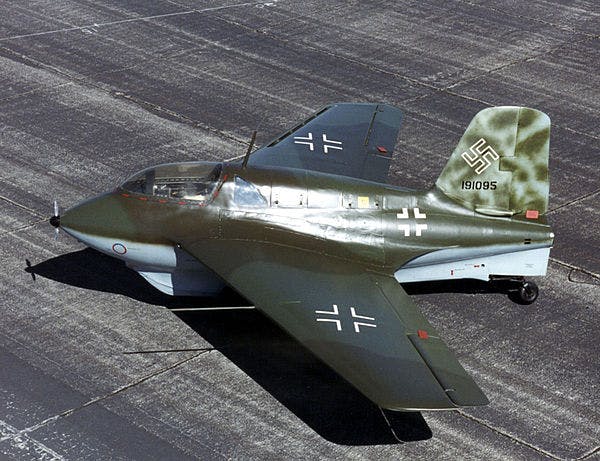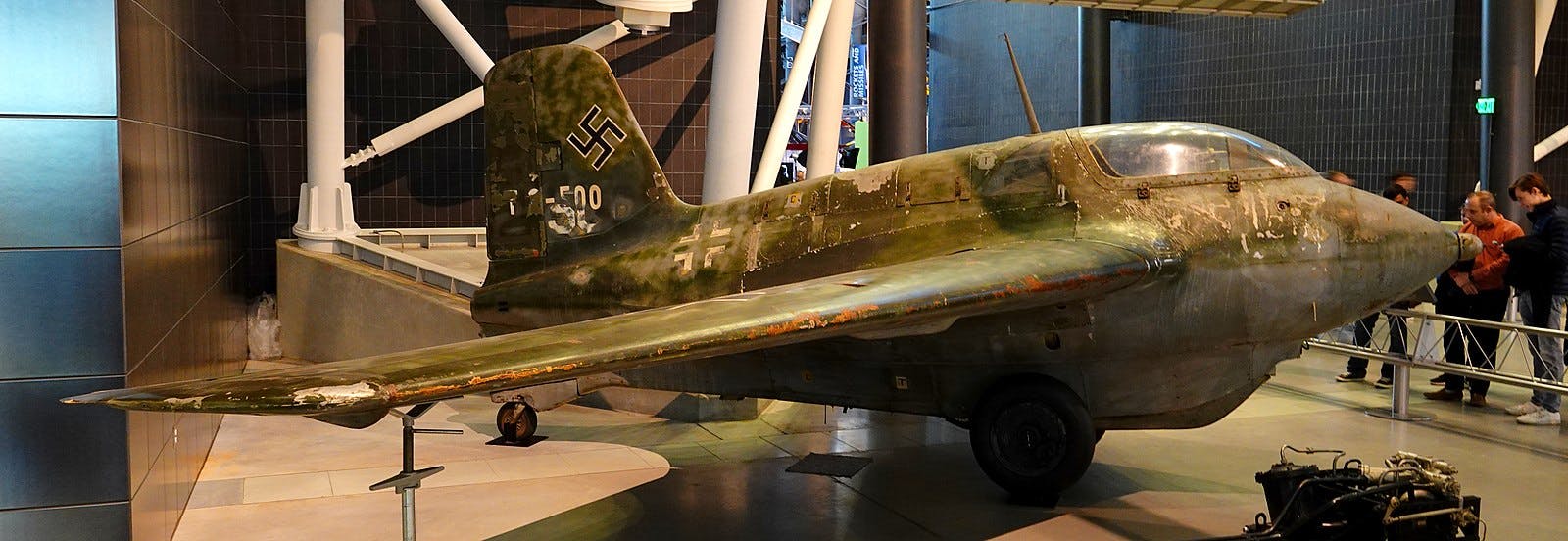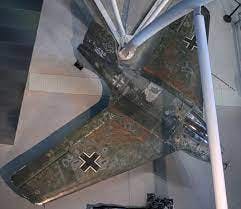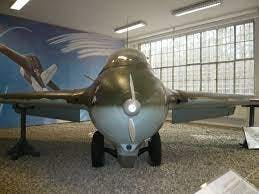Me 163 Komet: the rocket-powered German interceptor that could melt your face off

Blog
Say what you will about those wacky German National Socialists during the 1930s and 40s, they were not afraid of new technology. Some of the most innovative aircraft and weapons systems including the first cruise missile, the first jet fighter, the first assault rifle, the first guided bomb, and a whole mess of Messerschmitts came out of the brain trust of Hitler’s WWII Germany. In some cases, these groundbreaking design concepts shaped technology for decades. Others were spectacular failures and have modern analysts shaking their heads wondering how anyone could have ever thought they were a good idea, hindsight being 20/20 and all.
The tiny 18-foot-long Messerschmitt Me 163 Komet short-range interceptor is a prime example of the kind of mad-scientist Teutonic tech that was waaaay ahead of its time, was record-breaking in some important ways, but was so hazardous and problematic to employ that it was essentially useless in combat, and frequently fatal to its pilots and ground crew. Let’s go over some of the history of this bizarre, blazingly fast, rocket-powered deathtrap.

How fast was the Me 163 Komet?
In a word, fast. On October 2, 1941, the Me 163 set an unofficial world speed record (unofficial since Germany was, like, trying to take over the world at the time) of 623.8 mph (1,004.5 kph). The strange, short little bat-looking aircraft was the fastest thing flying for quite a few years (until beaten by Chuck Yeager in the Bell X-1 in late 1947), and later variants were claimed to have a top speed in level flight of 702 mph. Pilots reportedly regularly flirted with the sound barrier, though poor understanding of streamlining and supersonic airflow at the time meant that the Komet (like all other aircraft of the era) became unstable when nearing the speed of sound.
It’s been said that the flame that burns twice as bright burns half as long, and in this case it’s even worse. The Komet’s rocket fuel supply lasted roughly 8 minutes from takeoff before it ran out and the pilot was forced to glide back to a bumpy, possibly gruesome landing (more on this later). However, in those 8 minutes the little rocketship could kick some serious ass, at least as far as performance numbers are concerned. Its climb rate of 2.6 minutes to 29,500 feet and 3.35 minutes to 39,370 feet was truly staggering in its era. By comparison, the powerful P-47D Thunderbolt had a maximum climb rate of 2,750 feet per minute, while the 2,000-horsepower Messerschmitt Bf 109K variant utilizing water-methane injection, widely considered the fighter with the best climb rate during WWII, could only manage 3,540 feet/minute. The British Hawker Tempest V was the highest-climb-rate prop-driven fighter that saw any kind of combat, and it maxed out at 4,380 feet/minute. The Komet was more than twice as fast to reach high altitude than this.
In fact, the Me 163 climbed so quickly that its test pilots had to be fed a special low-fiber diet to prevent excess gas from building up in their intestines, which could expand painfully in a pilot’s gut in the un-pressurized cabin of the Komet as it climbed so high so quickly. There are also reports of pilots getting “the bends” as nitrogen bubbles formed in their joints due to the too-rapid decrease in atmospheric pressure. Ahh, the glamorous life of a test pilot!

Did the Germans build an interceptor that was too fast to be useful?
It could be credibly argued that the Me 163 was so fast that it was essentially useless in its intended combat role. As an “interceptor” the primary job of the Komet was to intercept and shoot down incoming heavy bombers close to das Vaterland. However, though the tiny, rocket-powered planes could reach 30,000 feet in under 3 minutes, that was effectively half of the aircraft’s usable rocket motor burn time, and a 500+ mph combat speed meant that the Komet couldn’t actually fly slow enough to spend much time with its pair of stubby (and unreliable) 30mm short-range cannons (each holding only 60 rounds) trained on an individual bomber lumbering along at around 200 mph or less. Komet pilots tried looping and diving attacks without much success, the pilots learning that any hits while flying the Komet required truly expert marksmanship. This problem was so real that a later version of the Komet did away with the forward-firing cannons altogether and instead the Luftwaffe mounted a series of vertically mounted single-shot cannons that would fire in series as the Komet flew underneath a bomber, and the guns were automatically triggered by a photo-sensitive cell. One report claims that a British Lancaster bomber was shot down by this new system, but it saw no other combat use.
The Komet was effectively a glider with momentary rocket propulsion, and it remained quite fast and agile even after the fuel ran out. All Komet pilots raved about the easy handling of the plywood-winged rocket-glider. There were reports of Allied fighter pilots learning to engage the Me 163 only after its engine cut out, but even so, the Komet pilots could often dive and evade enemy fighters. However, the same agility and high-lift wing design of the little rocketship-cum-glider made it twitchy and dangerous to land. The slightest updraft over an airfield and the Komet would be lifted into the air and the pilot could overshoot the runway… and since he or she (yes, Germany fielded several famous female test pilots, good on ya, Herr Göring) had no rocket propulsion remaining, this meant a bumpy and possibly fatal skid landing in a suitable field or pasture somewhere. And this brings us to the *ahem* acid test.
The sketchy landing skid and the “acid” fuel of the Me 163
The Komet was so small and light that designers couldn’t figure out a way to fit traditional landing gear into the design. Fixed external landing gear would create too much drag, and retractable landing gear would be too heavy and require too much power (the beanie-cap twirling propeller at the Komet’s nose was actually a pretty cool design, generating all the electricity the plane needed for its radio, instruments, and gun switches once airborne… but it had its limits).
So, the Me 163 used a clip-on, 2-wheeled dolly for takeoff that was jettisoned after the plane was airborne, and it landed (unpowered) on an oleo-pneumatic-cushioned metal skid that was extended before landing (if you were lucky). This skid often failed in deployment or caught an edge when sliding on imperfect surfaces, which flipped the Komet into a spin or nosed it into the ground. Several test pilots suffered spinal and/or facial-skull fractures during landings. This itself would be bad enough, but in test flights pilots learned that the highly corrosive, extremely volatile fuel that powered the rocket motor was not exactly Noxzema if it touched your skin.
The rocket motor was powered by two liquids, “T-Stoff” (80-90% hydrogen peroxide) and “C-stoff” (methanol, hydrazine, calcium permanganate, and water), which, when combined, qualified as a high explosive and instantly burst into flame. The compounds were so corrosive and volatile that the Komet’s tanks had to be specially constructed of aluminum (for T-stoff) or lined with enamel or glass (for C-stoff), and the fueling process completely separated using different crews and fuel trucks, and hosing down the plane and engine with water between fueling each liquid. Pilots wore specialized, rubber coated asbestos suits to protect them from flames and corrosive spills, but… well, let’s just say they didn’t always work.
In cases where a fuel line was damaged or a tank ruptured, the preferable result was an instant fireball and immediate death by conflagration as the two fuels came into contact with each other. If you were unlucky enough to survive a crash and not burn to death, you might share the horrific fate of Luftwaffe ace pilot Oberleutnant Josef Pöhs, who on one test flight released his takeoff dolly too early. The dolly bounced off the ground and struck the aircraft, rupturing the T-Stoff fuel line or storage tank. Pöhs immediately jettisoned his remaining fuel and banked around to make an emergency landing, missed the runway, caught the nose of the skid on rough ground, and flipped over. To the relief of his watching comrades his aircraft did not explode, but according to one account, “when they finally reached him and turned the Komet over they were greeted with a gruesome sight: T-Stoff leaking from the ruptured line had dissolved the unconscious Pöhs alive.” Ew.
Another source claims an eyewitness found “His right arm had been dissolved to nothing. The other arm as well as his head were little more than soft jelly.” Internet wags have postulated that even a super-high concentrate of Hydrogen Peroxide wouldn’t have been capable of melting the flesh from a pilot’s bones, particularly that quickly, but there are multiple sources quoting German ground crews that use the word “dissolve.” One crewman described the contents of the cockpit as being nothing but vapors and a pink slime at the bottom of the cockpit… nothing that could be identified as a human body.
Regardless, when ultra-concentrated oxidizers come into contact with human flesh, we can probably accurately call it “dissolving” because at some level, that’s exactly what is happening: Tissues and bone are rapidly oxidizing well beyond their “natural” state in a healthy person. And remember, at the same time the entire area will most likely be engulfed in a high-temperature fire, which also tends to be uncomfortable to any human sitting in the middle of it. It makes being locked inside a burning Tesla seem positively cozy.

Did the Me 163 Komet see any significant combat? What was its impact on the outcome of the war?
Due to its high speed and laughably short combat radius of 22 miles, it’s easy to surmise that the Me 163 Komet was more of a conversation piece than an effective interceptor. Most sources agree that it was not a great dogfighter, though it handled excellently even when unpowered/gliding. The stubby 30mm cannons it was armed with were intended to shoot down large, slow-moving bombers rather than small, fast fighters like the P-38 Lightning or P-51 Mustang, and they didn’t really work well at either task.
As for the Komet’s combat history, it’s somewhat problematic. Some sources say things like “it is unknown whether it ever flew in combat,” while other sources provide credible specifics:
- 29 Jul 1944: A Me 163 jet fighter attempted to disrupt a B-17 raid on Mersburg, Germany but was instead pursued by Captain Arthur Jeffrey in a P-38 fighter. Jeffrey chased the Me 163 jet fighter to a very low altitude and confidently reported a victory, but post war records indicated that there was no Me 163 lost on this particular date.
- 7 Oct 1944: 1st Lieutenant Elmer Taylor and 1st Lieutenant Willard Erfkamp of USAAF 364th Fighter Group, flying P-51 fighters, together shot down the German Me 163 rocket fighter piloted by Husser; Husser would survive the subsequent crash landing.
- 2 Nov 1944: About 12 Me 163 rocket fighters of German Jagdgeschwader 400 fighter wing intercepted a group of US bombers escorted by P-51 fighters east of Leipzig, Germany. The Germans shot down two bombers, while the American fighters shot down four Me 163 rocket fighters; the four German pilots shot down were Oberfeldwebel Horst Rolly, Oberfeldwebel Herbert Straznicky, Oberfeldwebel Gunther Andreas, and Jacob Bollenrath (rank unknown). Bollenrath's fighter would be the final Me 163 downing by a P-51 fighter.
Although reliable records are hard to come by, there is general agreement among most sources that between May 1944 and April 1945, Me 163 pilots shot down between 9 and 18 Allied bombers and lost a total of 10 Komets to combat-related damage.
What is clear, though, is that many, many more Komet aircraft, pilots, and ground crew were lost to accidents during the Me 163’s troubled development. Despite its forward-thinking technology and truly impressive speed and handling performance, it was an unequivocal failure strategically. Like so many other German advanced “terror weapon” projects, the Komet program used up huge amounts of resources and manpower that were urgently needed elsewhere late in the war, while ultimately contributing very little to the final outcome. Lucky for the rest of the world!
–By Jeff Davis, Intergalactic Scribe
Sources:
https://www.historynet.com/messerschmitt-me-163-bat-out-of-hell/
https://ww2db.com/aircraft_spec.php?aircraft_model_id=74
https://warfarehistorynetwork.com/article/me-163-the-devils-broomstick/